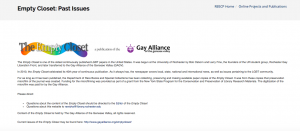When I was reading Metzger and Kalleher’s “Dearth of Native Voices in YAL,” the first thing I thought of was Chimamanda Ngozi Adichie’s TED Talk “The Danger of a Single Story.” In this talk, Adichie speaks about how when she was growing up in Africa she loved to read but there were barely any stories available that represented someone like her. She thought all stories had to be about white, blond, Anglo-Saxon protagonists in the developed world.

This is significant because it demonstrates the lack of representation in literature. Adichie felt like her story wasn’t one she could write about because it wasn’t what she had seen in literature. There were so few stories portraying African culture and they were heavily stereotyped. Adichie is advocating for more diverse voices to be represented in the literary world, and Metzger and Kalleher touch upon the same thesis in their article.
The lack of Native American voices in literature is not something I really considered before—something that is pretty ignorant of me and a result of my white privilege—so I am glad I was exposed to this problem in literature. One thing that really resonated with me is the need for underrepresented peoples to have more of an active voice in literature. It reminds me of the movie studios white washing PoC stories because they think the movie won’t make money if there’s not a well-known, money-making (read: white) actor attached to the picture. If historically and socially accurate stories about minority groups are made available to us, people will consume them.
Metzger and Kalleher highlight that not only does there need to be more stories about Native American life, but also, they need to demonstrate the history and the current lives of Native peoples so there are representations of them in the 21st century. I found this part especially important because when it comes to writing about unrepresented groups, because the stories about them are so limited, they often depict the discrimination and hardships faced by the minority group, as if that is the only part of their identity. It’s something I remember hearing about literature with gay characters: it’s important to have LGBTQ characters, but every plotline doesn’t have to be about their struggle with their sexual orientation or coming out, it can just be about them living their life as someone who happens to be LGBTQ. This is exactly the point the authors are making about Native American characters. Historical portrayals are crucial, but so are ordinary, everyday representations that show Native peoples as complex, multi-faceted individuals.
One thing from the article that didn’t really resonate with me was the continued use of “Indian” when the authors were referring to Native Americans. They initially introduce the word to highlight the negative stereotypes of Native Americans, and I didn’t expect them to use it interchangeably. I’m certainly not going to tone police anyone, especially for a word not used against my culture that they might be using and reclaiming as a stylistic device. However, I’m wondering what the authors’ intentions were when using that word since it’s considered not PC and not something typically used to refer to Native peoples anymore.
